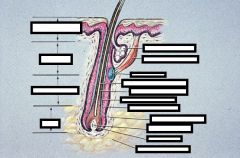![]()
![]()
![]()
Use LEFT and RIGHT arrow keys to navigate between flashcards;
Use UP and DOWN arrow keys to flip the card;
H to show hint;
A reads text to speech;
33 Cards in this Set
- Front
- Back
|
Main function of eccrine glands |
thermoregulation through evaporative heat loss, also excrete heavy metals, drugs, organic compounds and macromolecules |
|
|
Eccrine glands begin to develop at 3 months gestation and gradually appear everywhere by 5 months except for: |
External auditory canal Lips Clitoris Labia minora Glans Inner prepuce Nails
So, ears and genitals |
|
|
Area of the body with:
most eccrine?
least eccrine? |
most- palms, soles, axilla
lowest- back |
|
|
The eccrine secretory unit consists of two segments... |
1. Secretory coil- proximal coiled portion in lower dermis
2. Duct- long, thin channel that ends at the acrosyringium |
|
|
The secretory coil of eccrine glands contain 3 distinct cell types. What are they and what do they do? |
1. Clear cells- abundant mitochondria and lipofuscin granules, function in the secretion of water and electrolytes
2. Dark cells- smooth membrane with basophilic granules that produce sialomucin; resorbs Na
3. Myoepithelial cells- contractile cells with actin fibers! envelope both the clear and dark cells and enhance delivery of sweat to the skin; responds to CHOLINERGIC stimulation |
|
|
What is so important about the eccrine duct and microbes? |
The ductal epithelium is composed of 2 layers of cuboidal cells (basal ductal cells and luminal ductal cells) which secrete antimicrobial peptide B defensin!! |
|
|
The post ganglionic sympathetic fibers of eccrine glands are innervated by what? |
acetylcholine
**remember all preganglionics are Acetylcholine... post can either be sympathetic or parasympathetic |
|
|
3 types of secretion are? What type do eccrine ducts use? |
Merocrine- secretion via exocytosis (ECCRINE)
Holocrine- secretion by membrane rupture (SEBACEOUS)
Apocrine- secretion by membrane budding (APOCRINE) |
|
|
Is our sweat hypertonic, isotonic or hypotonic? |
HYPOTONIC! secretion of isotonic sweat by secretory coil in response to cholinergic stimulation, cells along eccrine duct partially reabsorb NaCl resulting in release of hypotonic sweat
**so the faster the flow rate, the less time the duct has to resorb NaCl, the more is secreted in sweat |
|
|
What is Frey's Syndrome? |
Damage to parotid glands and/or auriculotemporal nerve after surgery --> focal hyperhidrosis on damaged side |
|
|
Where is the clog in Miliaria crystallina? Miliaria rubra? Miliaria profunda? |
Crystallina- corneum
Rubra- spinosum
Profunda- deep |
|
|
LOOK AT A KODA OF CYTARABINE (AML) AND NEUROTPHILIC ECCRINE HIDRADENITIS |
DO IT NOWWWWWWWW |
|
|
Apocrine glands are derived from primary epithelial germ layer and are present in the entire skin surface of the embryo... slowly disappear and remain only on... |
axillae, anogenital region, periumbilical region, nipples, vermilion border |
|
|
Apocrine secretion is increased with what type of stimulation? |
CATECHOLAMINE AND CHOLINERGIC! |
|
|
What is apocrine bromhidrosis? |
bacterial decomposition of apocrine sweat on skin surface --> super smelly |
|
|
What is apocrine chromhidrosis? |
Secretion of pigmented (yellow, green, black) sweat, cause by increased numbers of deposition of lipofuscin in sweat glands |
|
|
What is pseudochromhidrosis? |
Stained sweat from bacteria (corynebacterium) |
|
|
What is Fox-Fordyce disease? |
Occlusion of apocrine glands resulting in follicular apocrine miliaria |
|
|
Sebaceous glands are found everywhere on skin except... |
PALMS AND SOLES |
|
|
What are...
Zeis glands Molls glands Fordyce granules Meibomian glands Montgomery tubercles Tyson glands |
Zeis- sebaceous glands on eyes Molls- apocrine on eyes Fordyce- sebaceous glands on vermilion lips and oral mucosa Meibomian- sebaceous on eyes Montgomery- sebaceous on areolae Tyson- sebaceous on leebs and prepuce |
|
|
Sebaceous glands always associated with a hair follicle... how many pilosebaceous units are there? |
THREE!!
Vellus (short hair, small glands) Sebaceous ( midsized hair, large glands) Terminal (long, thick hair, large glands) |
|
|
Stem cells in the hair follicle bulge can regenerate sebaceous glands following injury... those stem cells that are destined to become sebocytes have increased expression of what genes? |
Increased SHH and Myc (or decreased Wnt) |
|
|
What is the main component of sebum? |
Triglycerides |
|
|
Sebum secretion is not under neural control... what hormones are responsible for increased and decreased production of sebum? |
Androgens- stimulate sebum production (DHEAS more important than T/DHT)
EStrogens- decrease sebum production |
|
|
The microflora of the pilosebaceous unit is: |
Acroinfundibulum: p.ovale, malassezia
Midinfundibulum: s. epidermis
Deep: p.acnes |
|
|
Human sebum is distinguished from lipids of internal organs by the presence of: |
wax esters!
as sebum exits the sebaceous gland, it contains squalene, cholesterol, cholesterol esters, TG and wax esters. Human sebum is distinguished by the presence of wax esters and squalene, however lipids of internal organs contain a little squalene too. |
|
|
Meobomian glands are: |
meoBOOMian glands (Zeis also) sebaceous glands on the eyelids |
|
|
Sebaceous glands are ALWAYS/SOMETIMES associated with hair follicles? |
Sebaceous glands are usually associated with hair follicles, but free glands exist, especially on the lip (Fordyce spots), nipple (Montgomery tubercles), eyelids (meibomian glands), genitalia (Tysons glands) |
|
|
There are several types of specialized sebaceous glands that are not associated with a hair follicle... they include... |
1. Montgomery's tubercle (nipple) 2. Fordyce spots (lip) 3. glands of Zeis and Meibomian glands (eye) 4. Tysons (genitals) |
|
|
T/F
Sebaceous glands respond to cholinergic activity? |
FALSE
sebaceous glands respond to chemical stimuli such as hormones |
|

|

|
|
|
What is the major barrier component in the stratum corneum? |
Ceramide |
|
|
What hormone is homologous to a-MSH? |
ACTH
both ACTH and a-MSH are cleavage products of POMC |

